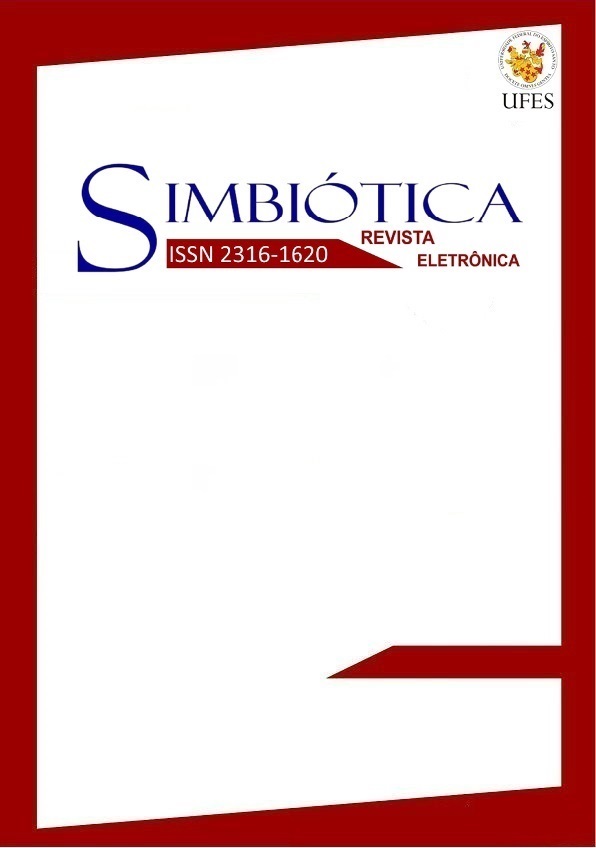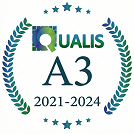Paisagens crepusculares: repensando as relações humanos-coiotes a partir da névoa no contexto de uma comunidade rural na Costa Rica
DOI:
https://doi.org/10.47456/simbitica.v9i3.39804Palavras-chave:
Antropoceno, Canis latrans, Ecologias afetivas, Interação humano-animalResumo
Este trabalho oferece uma perspectiva sensorial para refletir criticamente a respeito das formas de engajamento dos humanos, coiotes e outras entidades para-além-do-humano na comunidade rural de San Gerardo de Oreamuno, localizada na província de Cartago (Costa Rica). A névoa é um elemento característico da paisagem durante a maior parte do ano, e contribui para (re)configurar um “território multinatural” que afeta as relações entre diferentes vitalidades. Utilizo abordagens da etnografia multiespécies e da geografia-mais-do-que-humana para tensionar imaginários socioculturais sobre a dicotomia entre natureza e cultura, e, assim, gerar conhecimentos sobre as atmosferas afetivas e sensoriais envolvidas nas vivências e relatos das pessoas da comunidade. Finalmente, argumento que minha própria experiência de trabalho empírico me fornece elementos úteis para aprofundar a compreensão dos significados atribuídos à névoa e sua influência no surgimento das “ecologias da proximidade” que determinam as relações humanos-coiotes nessa comunidade.
Palavras-chave: Antropoceno; Canis latrans; Ecologias afetivas; Interação humano-animal.
Abstract
This paper critically reflects on human-coyote interactions emerging from more-than-human entanglements in San Gerado de Oreamuno, localized in Cartago province (Costa Rica). Through a sensory perspective, I examine the role of fog in (re)configuring an “multinatural territory” that affects relations between many vitalities. I also provide some theoretical insights from multispecies ethnography and more-than-human geography to problematize human-nature dichotomy and begin to understand the affective atmospheres involved in both physical experiences and oral accounts of local people. Finally, I suggest that my own interests provide me of interesting lens to frame the meanings attributed to fog and its influence on the emergence of “proximity ecologies” that determine human-coyote relations in that community.
Keywords: Anthropocene; Canis latrans; Affective ecologies; Human-animal interaction.
Resumen
Este trabajo ofrece una perspectiva relacional para reflexionar críticamente sobre las formas de participación de humanos, coyotes y otras entidades más-allá-de-lo-humano en la comunidad rural de San Gerardo de Oreamuno, localizada en la provincia de Cartago (Costa Rica). La niebla es un elemento característico del paisaje durante la mayor parte del año, y contribuye a (re)configurar un “territorio multinatural” que afecta las relaciones entre diferentes vitalidades. Utilizo las perspectivas de la etnografía multiespécies y de la geografía más-que-humana para tensionar imaginarios socioculturales sobre la dicotomía entre naturaleza y cultura, y, de esa forma, generar conocimiento sobre las atmósferas afectivas y sensoriales involucradas en las vivencias y relatos de las personas de la comunidad. Por último, argumento que mi propia experiencia de trabajo empírico me proporciona elementos útiles para profundizar en la comprensión de los significados a la niebla y su influencia en el surgimiento de las “ecologías de la proximidad” que determinan las relaciones humanos-coyotes en esa comunidad.
Palabras clave: Antropoceno; Canis latrans; Ecologías afectivas; Interacción humano-animal.
Referências
ALMEIDA, Mauro WB (2021), “Anarquismo Ontológico e Verdade no Antropoceno”. Ilha, v. 23, n. 1, pp. 10-29 [Consult. 23-06-2022]. Disponível em https://periodicos.ufsc.br/index.php/ilha/article/view/78405
ANDERSON, Ben (2009), “Affective atmospheres”. Emotion, space and society, v. 2, n. 2, pp. 77-81
BARUA, Maan (2020), “Affective economies, pandas, and the atmospheric politics of lively capital”. Transactions of the Institute of British Geographers, v. 45, n. 3, pp. 678-692 [Consult. 21-06-2022]. Disponível em https://rgs-ibg.onlinelibrary.wiley.com/doi/abs/10.1111/tran.12361
BENNETT, Jane (2010), Vibrant Matter: A Political Ecology of Things. Durham, N.C., Duke University Press.
BOONMAN‐BERSON, Susan; DRIESSEN, Clemens; TURNHOUT, Esther (2018), “Managing wild minds: From control by numbers to a multinatural approach in wild boar management in the Veluwe, the Netherlands”. Transactions of the Institute of British Geographers, v. 44, n. 1, pp. 2-15 [Consult. 19-06-2022]. Disponível em https://rgs-ibg.onlinelibrary.wiley.com/doi/pdf/10.1111/tran.12269
BRAUN, Bruce (2008), “Environmental issues: inventive life”. Progress in Human Geography, v. 32, n. 5, pp. 667-679 [Consult. 14-06-2022].
Disponível: http://citeseerx.ist.psu.edu/viewdoc/download?doi=10.1.1.455.4704&rep=rep1&type=pdf
BULLER, Henry (2008), “Safe from the wolf: biosecurity, biodiversity, and competing philosophies of nature”. Environment and Planning A, v. 40, n. 7, pp. 1583-1597 [Consult. 23-06-2022]. Disponível em https://journals.sagepub.com/doi/10.1068/a4055
DELEUZE, Gilles; GUATTARI, Felix (1987), A Thousand Plateaus: Capitalism and Schizophrenia. Minneapolis, MN, University of Minnesota Press.
ELLIOTT, Denielle; CULHANE Dara, (2016), A Different Kind of Ethnography: Imaginative Practices and Creative Methodologies. Toronto, University of Toronto Press.
ELLIS, Rebecca (2021), Sensuous and spatial multispecies ethnography as a vehicle to the re-enchantment of everyday life: A case study of knowing bees. in: A. Hovorka, Alice et al. (eds.), A Research Agenda for Animal Geographies. Massachusetts, Edward Elgar Publishing, pp. 87-100.
FARINA, Almo (2021), Semiotic landscape ecology: A novel approach to reconcile environment and humanities. Cambridge, Cambridge University Press.
FARINA, Almo; ELDRIDGE, Alice; LI, Peng (2021), “Ecoacoustics and multispecies semiosis: Naming, semantics, semiotic characteristics, and competencies”. Biosemiotics, v. 14, n. 1, pp. 141-165 [Consult. 11-06-2022]. Disponível em https://link.springer.com/article/10.1007/s12304-021-09402-6
FIJN, Natasha (2021), “Donald Thomson: Observations of Animal Connections in Visual Ethnography in Northern Australia”. Ethnos, v. 86, n. 1, pp. 44-68 [Consult. 17-06-2022]. Disponível em https://www.tandfonline.com/doi/abs/10.1080/00141844.2019.1606024?journalCode=retn20
FULLAGAR, Simone (2000), “Desiring nature: Identity and becoming in narratives of travel”. Journal for Cultural Research, v. 4, n. 1, pp. 58-76 [Consult. 22-06-2022]. Disponível em https://www.researchgate.net/publication/261647886_Desiring_nature_Identity_and_becoming_in_narratives_of_travel
HAUPTMAN, Jodi (2005), Beyond the visible: the art of Odilon Redon. New York, The Museum of Modern Art.
HEAD, Lesley (2016), Hope and grief in the Anthropocene: Re-conceptualising human–nature relations. New York, Routledge Press.
HINCHLIFFE, Steven (2007), Geographies of Nature: Societies, Environments, Ecologies. London: SAGE.
HINCHLIFFE, Steven; WHATMORE, Sarah (2006), “Living Cities: Towards a Politics of Conviviality”. Science as Culture, v. 15, n. 2, pp. 123-38 [Consult. 09-06-2022]. Disponível em https://www.taylorfrancis.com/chapters/edit/10.4324/9781315256351-24/living-cities-towards-politics-conviviality-steve-hinchliffe-sarah-whatmore
HODGETTS, Timothy; LORIMER, Jamie (2020), “Animals’ mobilities”. Progress in Human Geography, v. 44, n. 1, pp. 4-26 [Consult. 24-06-2022].
Disponível em https://journals.sagepub.com/doi/10.1177/0309132518817829
HOWES, David (2019), “Multisensory anthropology”. Annual Review of Anthropology, v. 48, pp. 17-28 [Consult. 21-06-2022]. Disponível em https://www.annualreviews.org/doi/10.1146/annurev-anthro-102218-011324
INGOLD, Tim (2013), “Prospect”. in: T. INGOLD, Tim; and G. Palsson (eds.) Biosocial Becomings: Integrating Social and Biological Anthropology. Cambridge, Cambridge University Press, pp. 1-21.
KIRKSEY, S. Eben; HELMREICH, Stefan (2010), “The emergence of multispecies ethnography”. Cultural anthropology, v. 25, n. 4, pp. 545-576 [Consult. 05-06-2022]. Disponível em https://anthropology.mit.edu/sites/default/files/documents/helmreich_multispecies_ethnography.pdf
LATOUR, Bruno (2004), “How to talk about the body? The normative dimension of science studies”. Body & Society, v. 10, pp. 205–229 [Consult. 07-06-2022]. Disponível em http://www.bruno-latour.fr/sites/default/files/77-BODY-NORMATIVE-BS-GB.pdf
LORIMER, Jamie (2010), “Moving image methodologies for more than-human geographies”. Cultural Geographies, v. 17, n. 2, pp. 237–258 [Consult. 19-06-2022]. Disponível em https://journals.sagepub.com/doi/abs/10.1177/1474474010363853
LORIMER, Jamie (2015), Wildlife in the Anthropocene: conservation after nature. USA, U of Minnesota Press.
NIEHAUS, Carmen et al, (2011), “Presencia de protozoarios y microorganismos relacionados con procesos de inmunosupresión humana en coyotes (Canis Latrans: Canidae) del Parque Nacional Volcán Irazú y campo agrícola limítrofe en Costa Rica”. Revista Ibero-latinoamericana de Parasitología, v. 70, n. 2, pp. 197-205.
PERLOFF, Nancy Lynn (1995), “Gauguin's French baggage: decadence and colonialism in Tahiti”. in: E. BARKAN and R. BUSH, Ronald (eds.) Prehistories of the future: the primitivist project and the culture of modernism. California, Stanford University Press, pp. 226-269.
PINK, Sarah (2009), Doing Sensory Ethnography. London, Sage.
ROSENZWEIG, Michael (2003), Win-Win Ecology: How the Earth’s Species Can Survive in the Midst of Human Enterprise. Oxford, Oxford University Press.
VAN DOOREN, Thom; BIRD ROSE, Deborah (2012), "Storied-places in a multispecies city." Humanimalia v. 3, n. 2, pp. 1-27. [Consult. 11-06-2022]. Disponível em https://humanimalia.org/article/view/10046
WHATMORE, Sarah (2002), Hybrid geographies: Natures cultures spaces. California, Sage.
WILSON, Helen F, (2019) “Animal Encounters: a genre of contact”. in A. BÖHM and J. ULLRICH (eds.) Animal Encounters, Cultural Animal Studies 4. Germany, Stuttgart J.B. Metzler, pp. 25-41.
Downloads
Publicado
Edição
Seção
Licença
Copyright (c) 2022 Luis Miguel Barboza Arias

Este trabalho está licenciado sob uma licença Creative Commons Attribution-NonCommercial 4.0 International License.
Autores que publicam nesta revista concordam com os seguintes termos:
a. Autores mantém os direitos autorais e concedem à revista o direito de primeira publicação, com o trabalho simultaneamente licenciado sob a Creative Commons - Atribuição-NãoComercial 4.0 Internacional.
b. Compartilhar - copiar e distribuir o material em qualquer meio ou formato.
Adaptar - remix, transformar e construir sobre o material para qualquer finalidade, inclusive comercial.
c. Autores têm autorização para assumir contratos adicionais separadamente, para distribuição não-exclusiva da versão do trabalho publicada nesta revista (ex.: publicar em repositório institucional ou como capítulo de livro), com reconhecimento de autoria e publicação inicial nesta revista.
d. Autores têm permissão e são estimulados a publicar e distribuir seu trabalho online (ex.: em repositórios institucionais ou na sua página pessoal) a qualquer ponto antes ou durante o processo editorial, já que isso pode gerar alterações produtivas, bem como aumentar o impacto e a citação do trabalho publicado (Veja O Efeito do Acesso Livre).
Authors who publish in this journal agree to the following terms:
a. Authors retain the copyright and grant the magazine the right of first publication, with work simultaneously licensed under the CCreative Commons - Atribuição-NãoComercial 4.0 Internacional.
b. Share - copy and distribute the material in any medium or format.
Adapt - remix, transform and build on the material for any purpose, including commercial.
c. Authors are authorized to take additional contracts separately, for non-exclusive distribution of the version of the work published in this journal (eg, publish in institutional repository or as a book chapter), with acknowledgment of authorship and initial publication in this journal.
d. Authors are allowed and encouraged to publish and distribute their work online (eg.: in institutional repositories or on their personal page) at any point before or during the editorial process, as this can generate productive changes as well as increase the impact and the citation of the published work (See The Effect of Free Access).












